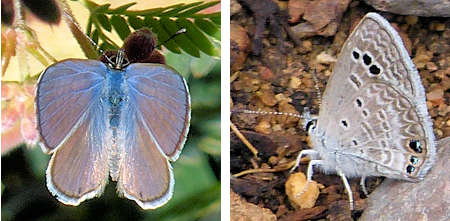Butterfly Garden Tips and Plants
FOOD PLANTS
Culinary Herbs
Fruit, Berries, Nuts
Peppers, Chilies
Strawberries
Tomatoes
Vegetable Calendar Zone 9
ORNAMENTALS
Grasses
Ground Cover
Perennials
Shrubs
Succulents
Trees and Palms
Vines
SPECIALTY GARDENS
Butterfly Garden
Erosion Control
Fragrance Garden
Hedges, Barriers, Screens
Hummingbird Garden
Long Blooming
Winter-Blooming
GARDENING TIPS
Dealing with Critters
Digging Holes for Plants
Fruit: Selection, Cultivation
Garden Bed: Sterilizing
Landscaping
Microclimates
Parasitic Plants
Plant Placement
Selecting Plants
Soil Prep for Vegetables
USDA Hardiness Zones
Planting, Watering, Shrubs, Trees
NURSERIES / SUPPLIES
Online
Phoenix
Tucson
MEETINGS
Phoenix Meetings
Tucson Meetings

Butterfly Garden Design
Butterfly Nectar and Caterpillar Food Plants
All plants are nectar sources except where noted
Aloysia gratissima: Whitebrush
![]() Anisacanthus quadrifidus var. wrightii:
Flame Acanthus
Anisacanthus quadrifidus var. wrightii:
Flame Acanthus
A caterpillar food plant for Elada and Arizona Checkerspot butterflies.
Aristolochia watsonii: Southwestern Pipevine
A caterpillar food plant for the Pipevine Swallowtail butterfly. This plant
does not supply nectar.
![]() Asclepias linaria: Pineneedle Milkweed
Asclepias linaria: Pineneedle Milkweed
A caterpillar food plant for Queen and Monarch butterflies.
![]() Asclepias subulata: Desert Milkweed
Asclepias subulata: Desert Milkweed
A caterpillar food plant for Queen and Monarch butterflies.
![]() Asclepias tuberosa: Butterfly Milkweed
Asclepias tuberosa: Butterfly Milkweed
A caterpillar food plant for Queen and Monarch butterflies.

Barkleyanthus salicifolius: Willow Ragwort
Caesalpinia pulcherrima: Red Bird of Paradise
Calliandra californica: Baja Fairy Duster
A caterpillar food plant for Blue butterflies.
Citrus species (all), such as
Citrus aurantium: Mandarin / Tangerine
are caterpillar food plants for the Giant Swallowtail butterfly. The caterpillar
resembles bird poop.
![]() Conoclinium greggii: Gregg's Mistflower
Conoclinium greggii: Gregg's Mistflower
A nectar source for Queen and Monarch male butterflies.
Funastrum cynanchoides:
Climbing Milkweed
A caterpillar food plant for Queen and Monarch butterflies.
Justicia spicigera: Mexican honeysuckle
A caterpillar food plant for the Texas Crescent butterfly.
![]() Lantana camara: Lantana
Lantana camara: Lantana
Lantana montevidensis: Trailing Lantana
![]() Monardella odoratissima subsp. villosa: Coyote Mint
Monardella odoratissima subsp. villosa: Coyote Mint
Ruta graveolens: Rue
A caterpillar food plant for the Black Swallowtail and Giant Swallowtail
butterflies.
Salvia coccinea: Scarlet Sage
Salvia elegans: Pineapple Sage
Salvia farinacea: Mealycup Sage
![]() Salvia greggii: Autumn Sage
Salvia greggii: Autumn Sage
Senna hirsuta v. glaberrima: Woolly Senna
A caterpillar food plant for Sulphur butterflies. It does not supply nectar.
Thymophylla pentachaeta: Golden Dyssodia
A caterpillar food plant for the Dainty Sulphur butterfly.
Zinnia acerosa: Desert Zinnia
Latest update: April, 2025
© 2008-2025 by GardenOracle.com

